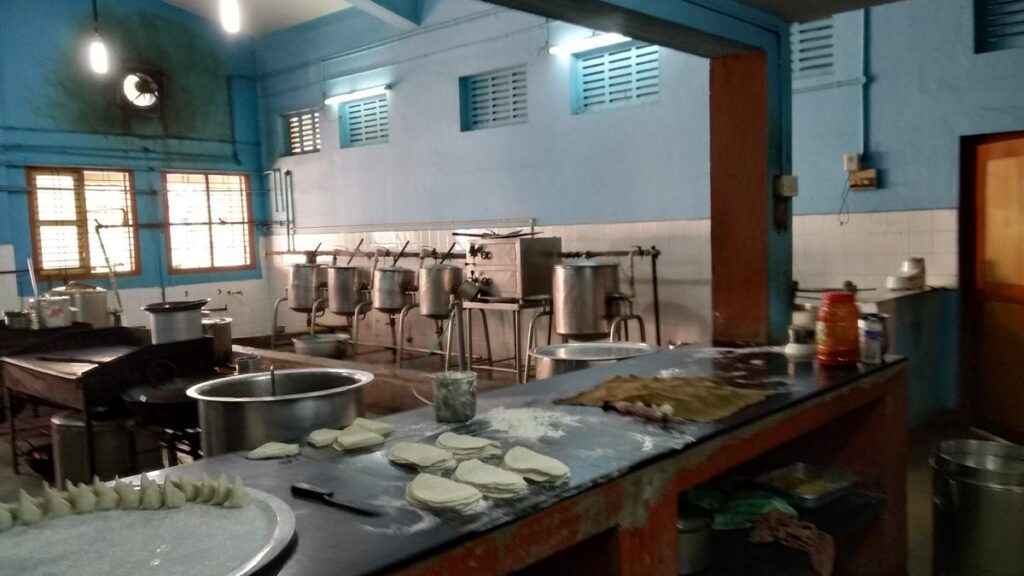
A community kitchen in Dakshina Kannada. A collaborative study on air pollution levels in 15 community kitchens in the district revealed that chefs are exposed to high levels of particulate matter (PM).
| Photo Credit: Special Arrangement
A collaborative study on air pollution levels in 15 community kitchens in Dakshina Kannada district of Karnataka where large-scale cooking is done reveals that chefs are exposed to high levels of particulate matter (PM).
The study titled ‘Assessment of health risks due to the inhalation of respiratory particulate matter generated in the community kitchens’ was carried out by Mangalore University in collaboration with IIT-Bombay and University of Miami, U.S.
It was published online in the Journal of Environmental Monitoring and Assessment, Springer in March 2025.
The study was done by K. Sudeep Kumara, a post-doctoral fellow at Mangalore University; N. Karunakara, Coordinator of the Centre for Advanced Research in Environmental Radioactivity (CARER), Mangalore University; Y. S. Mayya, Professor, Department of Chemical Engineering, IIT, Bombay; and Pratim Biswas, Professor, Department of Chemical, Environmental and Materials Engineering, University of Miami, U.S.A.
| Particulate Matter size fraction | Concentration (µg/m³) | Concentration (µg/m³) | Concentration (µg/m³) |
| WHO (recommended) | USEPA (recommended) | DK community kitchens (mean value) | |
| PM2.5 | 5 | 9 | 111 |
| PM10 | 15 | – | 119 |
WHO – World Health Organisation; USEPA – United States Environmental Protection Agency
Source: Mangalore University
Advanced real-time air quality monitoring devices (APT-MAXIMA by Applied Particle Technology Inc, USA) that measure particle size distribution from 0.3 µm (micrometre) to >10 µm (micrometre) were used in this study. Continuous and real-time monitoring of PM concentration was performed for 15 to 20 days. The study focused on measuring PM1, PM2.5, and PM10 airborne particles known to penetrate deep into the lungs and then into the bloodstream.
The continuous monitoring allowed the researchers to establish the essential database on air pollution levels in community kitchens, for which previous studies were non-existent.
The kitchens included in the research served large populations in schools, hostels, restaurants, and mid-day meal programmes, reflecting typical cooking environments in India.
The study was implemented by CARER of Mangalore University.
Findings of the study
The findings revealed that PM concentrations significantly exceeded acceptable air quality standards, especially during cooking hours. The PM1, PM2.5 and PM10 concentrations varied in the range of 40-286 µg m-3 (microgram per cubic meter), 58-418 µg m-3 (microgram per cubic meter), and 62-434 µg m-3 (microgram per cubic meter), respectively with corresponding geometric mean values of 74 µg m-3 (microgram per cubic meter), 111 µg m-3 (microgram per cubic meter), and 119 µg m-3 (microgram per cubic meter).
“The study has unveiled the build-up of pollutant concentrations in kitchens characterised by inadequate ventilation,” said Prof. Karunakara.
The study also revealed that the exposure to workers is higher in kitchens using solid bio-fuel when compared to other fuels, such as LPG, he said.
Health risk assessment
Health risk assessments based on the measured data indicated that kitchen workers are exposed to elevated health risks. The findings underscore the importance of effective ventilation systems in reducing inhalation-related health risks and ensuring safer indoor conditions for kitchen workers. It also lays the groundwork for large-scale environmental health monitoring, adaptable to diverse climatic and infrastructural conditions across India and beyond.
The observations of the study reveal that the current exhaust systems installed in the community kitchens are not optimal for air cleaning. The study has recommended that the authorities concerned take note of these findings and develop relevant guidelines to improve air quality in community kitchens.
The study has recommended that ‘a comprehensive, long-term study of indoor air pollution, especially cooking related, to generate a robust database is important’.
“This study is the first-of-its-kind to meticulously investigate the exposure of workers in Indian community kitchens to various size fractions of particulate matter, thereby shedding light on the associated health risks. Notably, India, with the world’s largest population, adds significance to the relevance and implications of this research,” he said.
Research on societal issues
P. L. Dharma, Vice-Chancellor, Mangalore University, said that it is a matter of great satisfaction that the university is actively engaged in research on issues relevant to society, and will continue to undertake such studies in the future as well.
Published – June 19, 2025 02:30 pm IST

